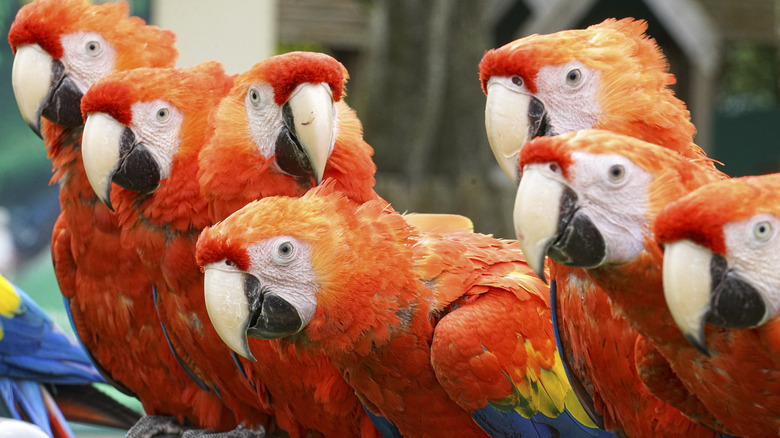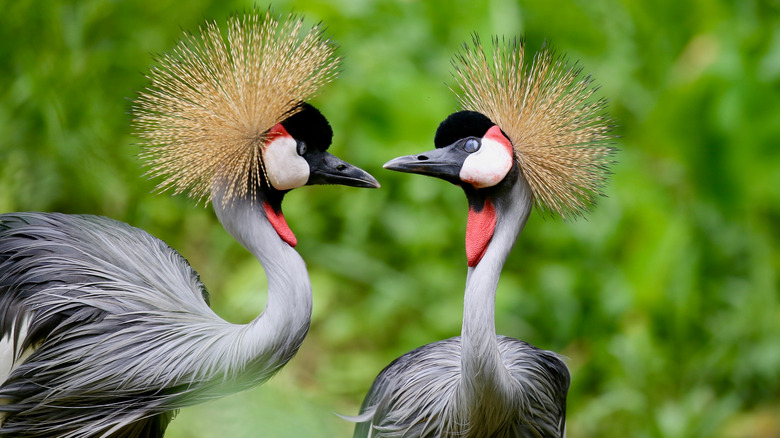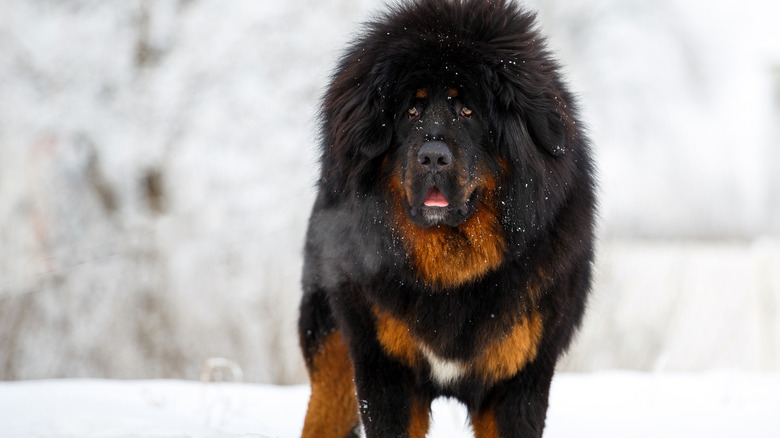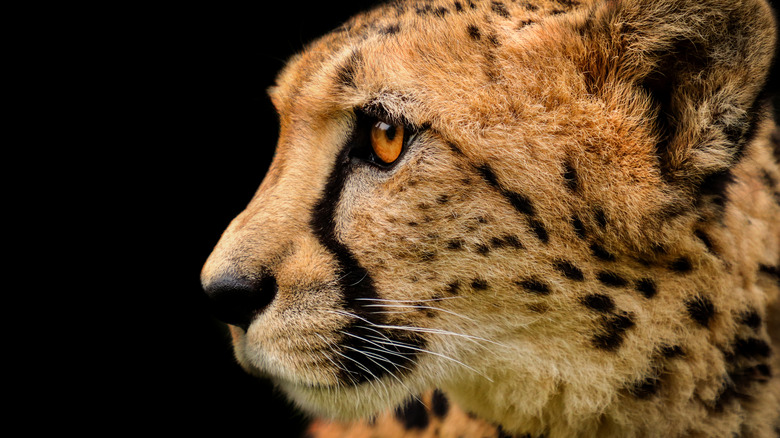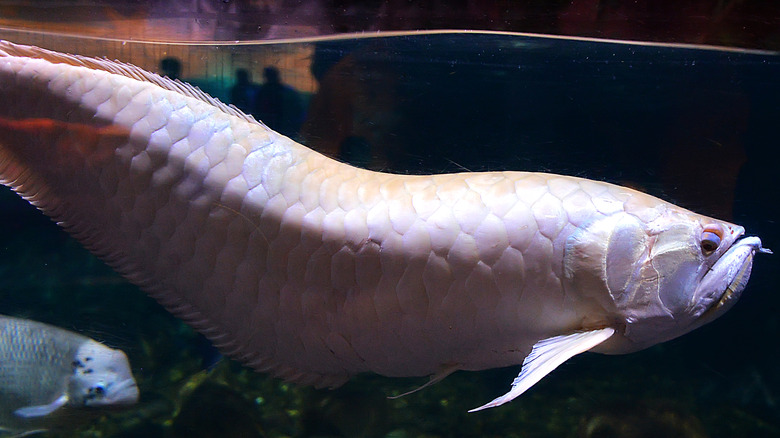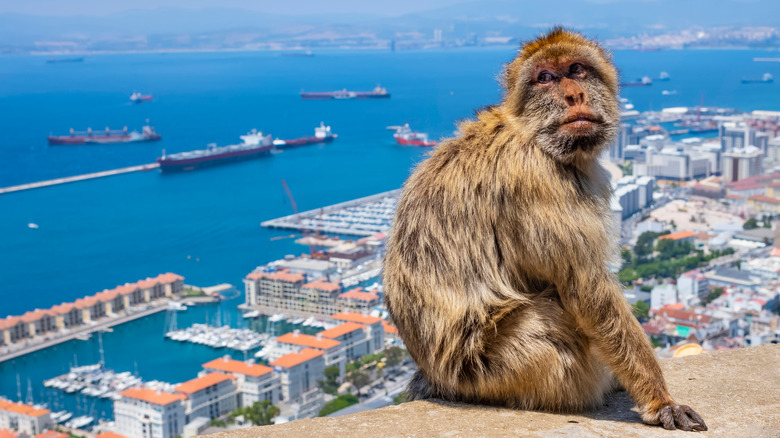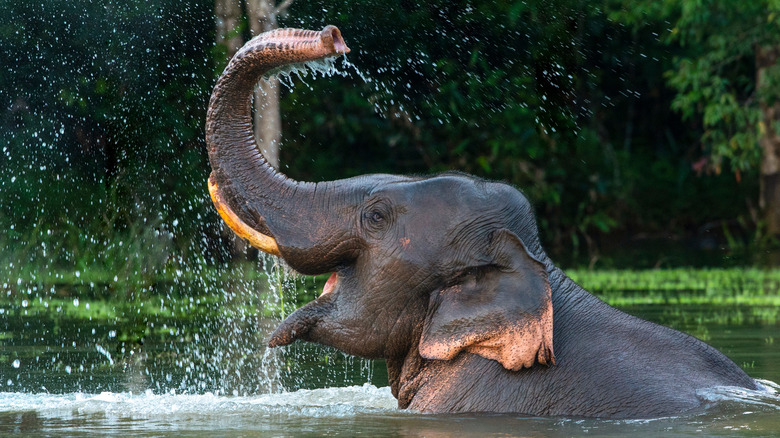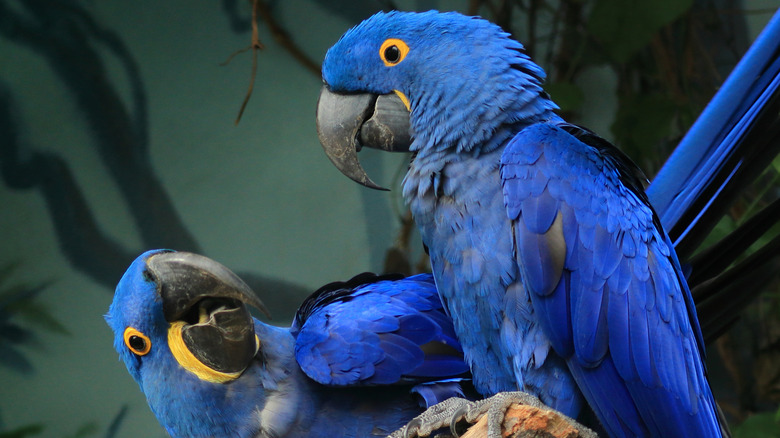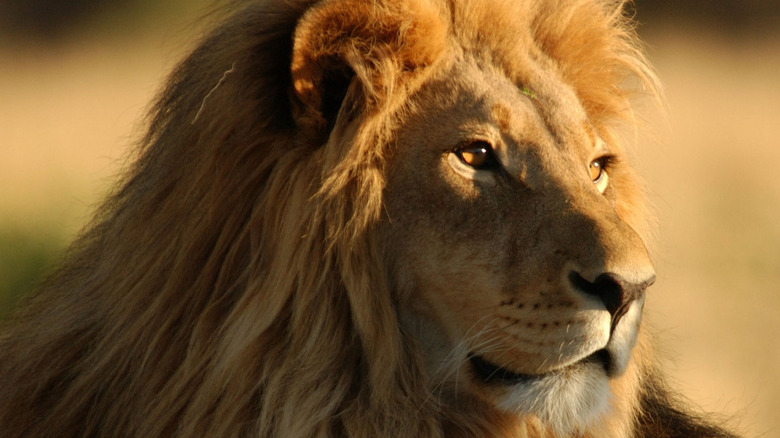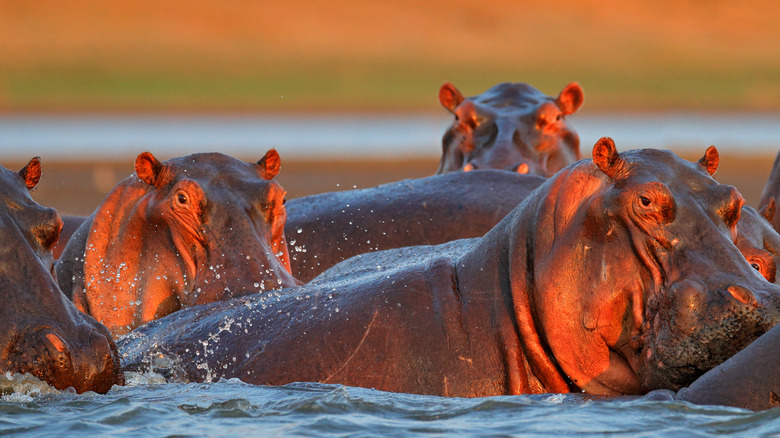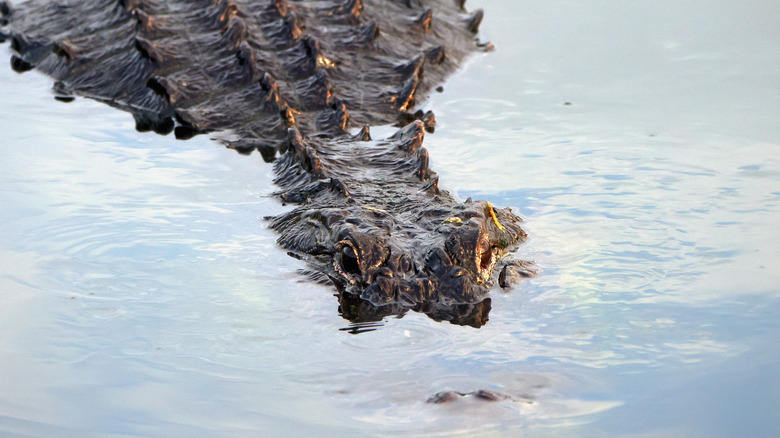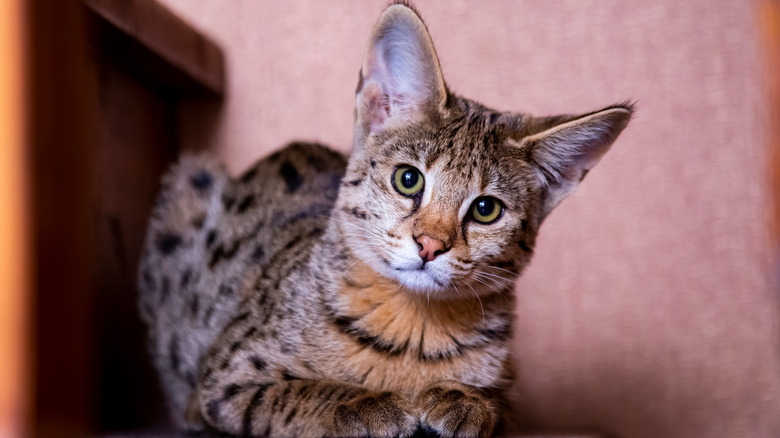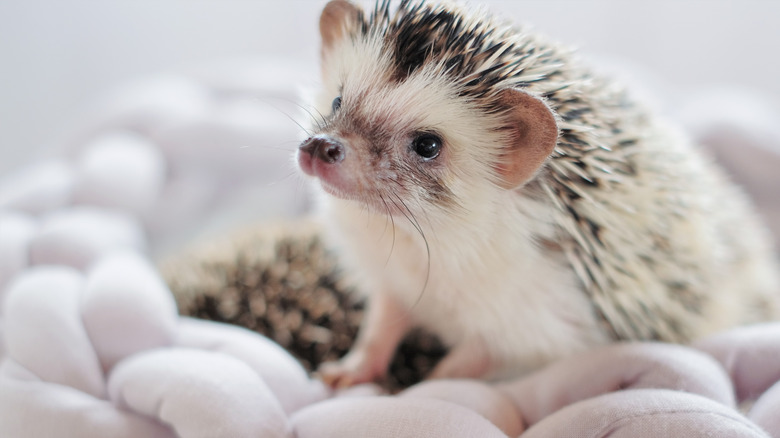How These Animals Became Status Symbols
A status symbol is defined as something that a person owns that shows "wealth or a high social status." Typically, status symbols are things like flashy cars or expensive watches, but for some, the ultimate status symbol is a living thing.
Unusual and exotic pets are often expensive and difficult to acquire and keep, so it's unsurprising that some use their animals to boost their prestige. These can be anything from an expensive "designer" dog to a tiger. As described by veterinarian Laurie Hess for CNBC, some exotic animals can be amazing companions, but they may need more special care than an ordinary pet, which not every owner is prepared for. Other wild animals are unsuited to living in captivity at all, and inexperienced owners bringing them home can have devastating consequences. Richard Patch, vice president of federal affairs for the ASPCA explained, "People get these animals when they're very young, manageable and cute. But they grow up to be wild animals, kept in cages, chained up or loose. There's just no good outcome there."
From gorgeous birds to apex predators, animals have been used all over the world to show off wealth and power. Some help their owners get followers on Instagram while others are used to guard illegal drugs. This is how these animals became status symbols.
Gray crowned cranes
There are 15 species of crane, but only two are royalty. The "crowned cranes" are particularly beautiful birds, standing three feet tall with impressive gold feathers sticking up from their heads like a halo in a medieval painting. As noted by National Geographic, their striking appearance has made them the beloved national bird of Uganda — but it has also made them highly prized on the black market.
As reported by CNN, having these endangered birds in a private garden or wandering around on hotel grounds has become a status symbol. With their natural habitat being threatened and more and more young chicks being taken from the wild to be aesthetically pleasing living decor, the number of wild gray crowned cranes dropped to a mere 300 birds in 2012.
While taking them out of the wild to live in private gardens was technically illegal, most people who owned the cranes had no idea that it was a crime. As a result, there were many birds living in urban areas outside private homes, but very few left in their natural habitats. Rwandan vet and conservationist Olivier Nsengimana urged the Rwandan government to create a program that allowed owners of the birds to turn in any gray crowned cranes they might have without being arrested or fined. Hundreds of healthy cranes have been reintroduced to the wild. Those that can't survive in the wild (usually due to clipped wings) are sent to a crane sanctuary run by Nsengimana.
Tibetan mastiffs
Dogs of all kinds have been used as status symbols as well as — and, sometimes, instead of — companions. The most expensive of these breeds is probably the Tibetan mastiff — a guard dog rumored to be strong enough to bring down a tiger. In 2014, at a luxury pet fair in China, a single Tibetan mastiff was sold for almost $2 million.
As The Washington Post reported, the $2 million dog was hardly alone. In what has been called "the luxury dog trade," the breed became seen as investments representative of wealth and status. One breeder stated, "Pure Tibetan mastiffs are rare, just like our nationally treasured pandas, so the prices are high."
The demand for the massive dogs didn't last. Breeders bred more Tibetan mastiffs than there was demand for, and their price has decreased dramatically. In 2019, CGTN reported that the price for pure Tibetan mastiff puppies was only $1,500. Meanwhile, puppies that had less certain lineage were outright abandoned. The unneutered, released dogs bred with other strays, causing a boom in their population, all without homes. The enormous and untrained dogs travelled to populated areas, where they were a threat to humans, livestock, and wildlife. Living up to the legends, these stray Tibetan mastiffs have been seen attacking wild bears and wolves.
Cheetahs
The ultra elite of Saudi Arabia have a favorite prestige pet: cheetahs. As revealed by an investigation by wildlife conservations released in The Times, 3,600 cheetahs were smuggled across borders to be sold illegally between 2010 and 2019. More than half were headed for Saudi Arabia to become pets for extremely wealthy buyers. Cheetahs as pets are favorites of influencers, showing up on Instagram alongside posts about luxury items and incredible homes. Cheetahs as palace pets have a long history, though, from Egyptian pharaohs to the Medicis.
Cheetahs are notoriously difficult to breed in captivity, so the cubs sold as pets are almost always taken from the wild. National Geographic's investigation into the cub trade described the animals being shipped in mesh plastic bags. A mere 10% of sales of cheetah cubs are stopped by law enforcement. Those that are recovered sometimes can't be returned to the wild. Cubs that were taken too young never learned the skills they would need to survive and have to remain in sanctuaries.
As explained by National Geographic however, cubs being smuggled for sale as exotic pets in the illegal pet trade is more than just a tragedy for the individual animals. With less than 7,000 cheetahs living in their natural habitat, the hundreds of cubs taken are desperately needed in the wild.
Dragon fish
The Asian arowana, sometimes referred to as a dragon fish, is the single most expensive fish in the world. They are reportedly favorites of the yakuza. In 1975 it was classified as a rare species, and international sales were forbidden — which accidentally transformed it from a niche aquarium oddity to a blackmarket luxury item with a market rife with crime.
There are very few Asian arowanas in the wild, but breeders still breed them in farms with tight security. According to a report from the New York Post, each individual fish is microchipped. Expert Emily Voight (via CNBC) has stated that individual Asian arowanas cost up to $300,000. Like the Tibetan mastiff, the market was flooded by legal farm-bred versions in 2012, which brought down the inflated prices for some forms of Asian arowanas. In 2016, however, more than 200,000 illegal sales were still conducted. The most highly prized are white albino fish, already at their full size of three feet long.
Obsession with these "dragon fish" can be expensive and even deadly. Some owners have gone as far as to get plastic surgery for their fish to make the expensive creatures look as good as possible. Arowanas were stolen in heists in Singapore and Malaysia — one of which included the brutal murder of an aquarium shop owner.
Primates
Humans have kept monkeys and apes in the home for thousands of years. In modern times, many still want to keep these creatures in the house, but keeping a monkey as a pet can prove disastrous or even deadly — for the human or the animal.
As noted in "Greek and Roman Household Pets" (via University of Chicago), keeping primates is believed to have been common for the rich and powerful in the ancient world — though one of the earliest accounts is dubious about maintaining them in the home. Wexford archaeologists Colm Moriarty and Adrienne Corless described the excavation of a monument in early Iron Age Ireland, where the skull of a Barbary ape was discovered. It is believed that it must have been brought there from Africa between 390 B.C and 20 B.C.
There are approximately 15,000 primates being kept as pets in the United States today. As described by National Geographic, some people are willing to pay thousands for primates as status symbols and sometimes "substitute children." When monkeys and apes behave like what they are — wild animals — there can be devastating consequences. Humans who adopt baby monkeys find that their personalities change as they age. They are prone to attacking humans to establish dominance, and they are capable of doing significant damage. This can lead to brutal treatment from desperate owners, like locking them in cages or removing their teeth. Still more primates are sold to laboratories or simply abandoned, overwhelming sanctuaries.
Elephants
Some animals are status symbols when they're pets. Others are exciting and "exotic" enough that just being around one — and posting a picture — can be the status symbol. People love elephants. They are willing to travel around the world to see them. Unfortunately, that love has grown into an industry that forces elephants to entertain their international human fanbase.
As detailed in "Entertaining Elephants" from Johns Hopkins University Press, elephants were unwilling stars of circuses in America between 1800 and 1940. Elephants being forced to entertain people is nothing new, but in modern Thailand, an industry around elephant tourism has been born. According to the New York Times, approximately half of the elephants in Thailand are captive. Originally, most of them were used to haul logs, but when commercial logging was made illegal in 1989, the people who owned elephants were left with no source of income. They needed a new use for elephants. Commonly, elephants are made to give rides to tourists, giving tourists the opportunity to take many pictures with the elephants. Sometimes elephants "perform" in elaborate shows, wearing costumes and doing tricks.
Conservation groups are working to create settings where people who love elephants can travel to see the animals safely without reducing them to photo ops at the expense of elephant health and safety. Elephant Nature Park is a Thai sanctuary that has provided safe homes for dozens of elephants since 1990, while still allowing guests to tour and volunteer.
Macaws
These massive and colorful parrots are prized as pets. In excavations of pueblos over eight centuries old in the American southwest, archeologists have discovered macaw skeletons. In modern times, no species of macaw is found in the United States natively. It is believed that the ancient parrots arrived in the U.S. the same way they do today — intentionally. Their incredible plumage is believed to have been used as a "signifier of prestige" by ancient Americans, according to Scientific American.
There are 18 kinds of macaws, and all of them are coveted as pets by people today. As stated in Britannica, the blue hyacinth macaw is the largest parrot in the world, while the scarlet macaw's distinctive plumage makes it likely the most recognizable of all parrots. These birds are highly intelligent and social, and in their rainforest homes they live in large groups. They are also beloved for their ability to mimic sounds they hear, leading many owners to teach their macaws words.
While good owners form strong bonds with their parrots, irresponsible ones are dazzled by the incredible appearance of macaws and underestimate the amount of work that goes into caring for these intelligent, social animals that can live up to 65 years. In an interview with VPM, Matt Smith, executive director of parrot sanctuary Project Perry, urged people to spend time volunteering with parrots, "and then make the decision: can you really care for a parrot for its life?"
Lions
Lions have been called the kings of the jungle (despite not actually living in the jungle). Historical kings from Louis VIII to Richard I have had nicknames inspired by lions. These apex predators are often used to symbolize prestige and power — which may be why being photographed with one is popular with everyone from TikTok stars to the Crown Prince of Dubai.
Photos and videos of people interacting with lions like domestic animals are often popular on social media, but, as described by Newsweek, the public is increasingly critical of exotic animals being used for clout.
"If someone buys a very expensive animal, he is boasting that he has enough money to get anything he wants," Jasim Ali, manager of Ras Al Khaimah Wildlife Park, told CNN, "If he has a tamed wild animal like a lion, he is trying to show off that he is brave. But this is not courage; this is animal rights abuse."
Hippopotamuses
The hippopotamus is considered one of the deadliest animals on the planet. As reported by the BBC, they are responsible for the deaths of about 500 people in Africa every year. Who would view these animals as good pets? Pablo Escobar.
In the 1980s, the kingpin had four hippos illegally brought to his private estate. Today, their offspring are roaming free around Bogotá as what the Washington Post described as the "largest invasive species." There are now over 100 hippos in Colombia.
What started with one drug lord's desire to have an impressive and dangerous exotic pet is now an international legal affair. Initially, Columbia had considered putting the animals down, but the "cocaine hippos" have since been legally dubbed "interested persons" in the U.S. court system — the only animals ever to receive this designation. The U.S. Department of Agriculture has provided a chemical called GonaCon to potentially sterilize the animals.
Alligators
Alligators have existed for millions of years — these aquatic reptiles shared the planet with dinosaurs. Wildlife expert Corbin Maxey told Business Insider that alligators were unlikely to attack a human (in fact, the chances are better for being attacked by a cow.)
"If you leave them alone, they will more than likely want to leave you alone," Maxey stated. The few attacks that do occur can be deadly, however. Depictions of these attacks likely contributed to the perception of alligators as man-eaters. As seen with other apex predators, some individuals are attracted to the idea of a deadly pet.
In 2019, the New York Post reported that law enforcement raided a house in Pennsylvania that was being used to store massive amounts of illegal drugs. It had an unusual form of security: an alligator. The guard alligator was dubbed "El Chompo." He has since been retired from security and sent to live at a zoo.
Savannah cats
Unlike many exotic pets, the Savannah cat is bred to be a household pet — but according to some, that doesn't necessarily mean it's domestic. Savannah cats are crossbreeds of regular house cats and African wildcats called servals. According to The Times, these animals are a new way for the ultra-rich to show off their wealth. These cats are extremely expensive. One first-generation Savannah cat can cost $15,000-20,000 from a breeder.
The breed is a new one. The very first Savannah cat was bred in 1986, and The International Cat Association accepted the official Savannah cat breed standards in 2001.
Savannah cats are the largest cats kept in the home, and they can jump higher than any other house cat. They can jump around seven feet vertically into the air. According to Discovery UK, these pets are controversial. Some states don't consider them domestic cats and have made owning one illegal.
African pygmy hedgehogs
Many animals used as status symbols are massive, like elephants, or powerful predators, like cheetahs. Some, however, are just a little pointy.
As described by Hugh Warwick, an ecologist specializing in hedgehogs, the adorable African pygmy hedgehog has been the subject of a "pet fad" since the 2000s. They were first brought to the United States by a single breeder in 1991. It is believed that he purchased 2,000 hedgehogs for 50 cents each and brought them into the U.S. along with some tropical fish, crabs, and baby crocodiles (which he was sent to prison for). Despite the breeder's run-in with the law over the crocs, the hedgehogs were a massive success.
In August of 2021, Wired reported that some influencers were getting hundreds of thousands of followers by posting their pet hedgehogs with adorable props, settings, and outfits. The demand for hedgehogs has only increased, but most first-time owners struggle to provide the care hedgehogs need. While they are adorable and photogenic, they require a suitable habitat, the correct temperature, and frequent cleaning to be healthy.
